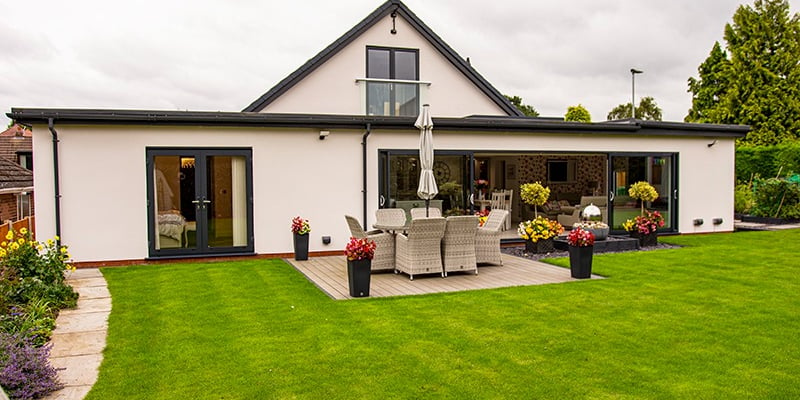Wraparound Extension Ideas UK 2025 – Design Trends, Costs & Planning Guide
5/21/20253 min read


Wraparound Extension Ideas UK: The Ultimate Design Guide for 2025
If you're looking for a dramatic way to transform your home’s layout and living experience, a wraparound extension offers one of the most powerful and flexible options. Combining both a rear extension and a side return, wraparound extensions allow UK homeowners to unlock dead space, create large open-plan living areas, and add significant value to their properties—all without moving house.
In this 2025 guide, we explore what a wraparound extension is, planning and regulation requirements in the UK, trending design ideas, costs, and practical tips to bring your vision to life.
What Is a Wraparound Extension?
A wraparound extension is a type of single-storey extension that merges a rear extension with a side return extension, forming an L-shaped footprint. It’s ideal for terraced and semi-detached homes with narrow side alleys or unused side plots.
By building across the rear and into the side return, this extension style:
Increases the width and depth of your living space
Creates room for larger kitchens, dining areas, utility spaces, and more
Allows for open-plan layouts and improved indoor–outdoor connection
Brings in more natural light through skylights, roof lanterns, and wide doors
Planning Permission & Building Regulations in the UK
In many cases, wraparound extensions require full planning permission, especially because they go beyond the typical limits of Permitted Development (PD) rights.
You’ll likely need planning permission if:
Your extension exceeds 3m (terraced) or 4m (semi-detached) at the rear
Your side return extends beyond half the width of the house
The total extension covers more than 50% of your original garden space
You live in a conservation area, or your house is listed
You’re making changes to the principal (front-facing) elevation
You must also adhere to UK Building Regulations, covering:
Structural stability and foundations
Energy efficiency and insulation
Fire safety, including escape access
Ventilation, especially in kitchens and bathrooms
Drainage and damp-proofing
Trending Wraparound Extension Ideas in the UK (2025)
Open-Plan Kitchen-Diner with Island
Transform your ground floor into a sociable hub. A wraparound layout allows for a spacious kitchen with a central island, breakfast bar, and dedicated dining area—all flowing out to the garden with bifold or sliding glass doors.
Daylight-Flooded Family Lounge
Install large rooflights, roof lanterns, or even a partially glazed ceiling over the side return to make a once-dark space full of natural light. It’s ideal for play areas or relaxed living spaces.
Hidden Utility Room in the Side Return
Use the narrower side section to conceal practical spaces like a utility room, pantry, or even a home office nook—freeing up the main area for living and entertaining.
Zen Garden Room
Turn your extension into a wellness retreat with full-height windows, greenery, soft timber flooring, and tranquil tones. Perfect for yoga, reading, or morning coffee.
Gallery Wall and Feature Shelving
Maximise vertical space along the side walls with built-in shelving, gallery-style art displays, or indoor plant installations. It creates a cosy, creative feel.
Internal Courtyard Feel
Use floor-to-ceiling glazing and a continuation of materials (like stone or timber flooring) from indoors to outdoors to blur the line between home and garden. Some even install corner doors that open up completely.
Wraparound Extension Costs in 2025 (UK)
In 2025, expect to pay between £2,200–£3,200 per square metre for a standard build.
For a mid-sized 30 m² wraparound space, that’s typically £66,000–£96,000.
High-end projects with bespoke features (like smart lighting, underfloor heating, custom kitchen joinery, and structural steel) can go well over £100,000.
Additional fees may include:
Architect & structural engineer: £3,000–£6,000
Planning permission (if required): £250–£500
Building Control inspections: £500–£1,000
Party Wall agreements (if applicable): £1,000–£1,500
Will a Wraparound Extension Add Value?
Absolutely. A well-designed wraparound extension can add up to 20% to your property’s value, especially in cities like London, Manchester, Birmingham, and Bristol. Buyers are increasingly prioritising open-plan layouts and natural light—features that wraparound extensions excel in delivering.
Practical Tips Before You Build
✅ Hire a specialist architect or design-build company with wraparound experience
✅ Check with your local authority for planning requirements
✅ Consider how the new space will flow with the existing layout—don’t just focus on square footage
✅ Choose high-quality glazing for the side return to maximise daylight
✅ Plan storage carefully—built-ins can preserve openness without clutter
✅ Think long-term: quality insulation, ventilation, and heating will save money over time
Final Thoughts
A wraparound extension is a bold and beautiful way to transform your UK home. Whether you're craving a larger kitchen, a light-filled living space, or more functional zones for family life, this type of extension ticks all the boxes. While the process involves planning, cost, and time, the reward is a home that truly works for modern living.
As we move through 2025 and beyond, flexibility, sustainability, and connection to the outdoors will define home design—and wraparound extensions deliver on all fronts.